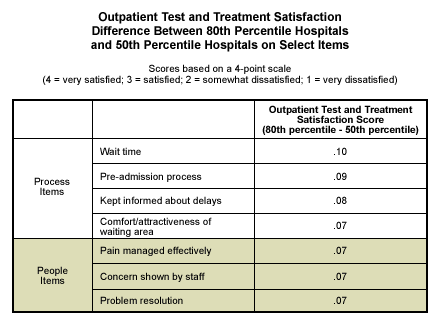Outpatient test and treatment services include a mixture of non-surgical outpatient procedures, including laboratory, radiology, and physical rehabilitation. These services represent areas of rapid growth in the healthcare field, both in volume and in hospital revenue. However, many hospitals are at risk for losing this revenue, as freestanding, non-hospital health providers are siphoning outpatient test and treatment services. In order to keep their customers, hospitals must build patient satisfaction and loyalty for outpatient test and treatment services.
What Do the Best Outpatient Test and Treatment Facilities Do Differently?
As with inpatient, outpatient surgery, and emergency departments, Gallup compared average outpatient test and treatment facilities (those scoring in the 50th percentile of Gallup's 2003 healthcare database) with best-practice outpatient test and treatment facilities (those scoring in the 80th percentile of the database). The analysis revealed seven question items that most differentiate the 50th percentile facilities from the 80th percentile facilities. As with the inpatient and outpatient surgery facilities, four of the seven items are "process" items (relating primarily to operations rather than human interaction) and three are "people" items, relating primarily to human interaction.

Process Items
The three items that most differentiate average outpatient test and treatment facilities from best-practice facilities (wait time, pre-admission process, and staff kept patient informed about delays) are all process questions. However, only one of these process questions -- staff kept patient informed about delays -- has a high impact on overall patient satisfaction.
Therefore, outpatient test and treatment facilities seeking to improve patient satisfaction would be well served to work on communication about delays. Communicating about delays involves more than simply stating there will be a delay -- employees must manage patient expectations by knowing the service delivery standards and providing specific, ongoing communication about wait times.
Although wait time is a low-impact area when it comes to overall patient satisfaction, improving wait time would obviously help improve scores on the "staff kept patient informed about delays" question. If wait times are reduced, there is no need to explain delays. In turn, a smoothly operating pre-admission process directly reduces patient wait times. That's why best-practice managers know their process and average throughput times for various procedures. They know which bottlenecks to focus on, and establish firm service delivery standards to facilitate patient communication.
For outpatient test and treatment facilities with high levels of patient dissatisfaction, these process items can be productive areas to focus on. However, the Gallup database shows that there are few highly dissatisfied patients on these questions, suggesting that for most facilities, focusing solely on admission, wait times, and communication about delays has begun to offer diminishing returns.
People Items
All three of the "people" questions that most differentiate average and best-practice facilities (pain management, concern shown by staff, and problem resolution) are items with a high impact on patient satisfaction, and are therefore areas of great potential return. The first item, pain management, may be an issue that doesn't immediately come to mind in an outpatient test and treatment setting, where minor procedures are performed. On a standardized pain scale, pain for things like physical therapy is often low -- some may even characterize it as "discomfort." However, fear of pain from a needle stick is real to many patients, although it may be minor on the pain scale. More than anything, pain management is about sensitivity to a patient's needs and feelings.
More generally, staff members need to show that they care about their patients. The "concern shown by staff" item is the third-highest impact item on overall outpatient test and treatment patient satisfaction. The second-highest impact item is problem resolution. When a problem arises, staff members need to quickly fix the problem to the patient's satisfaction.
Bottom Line
For outpatient test and treatment facilities seeking to be the best, my advice is simple: Manage pain and discomfort effectively, show concern for the patients, communicate well about delays, and when something goes wrong, fix it.